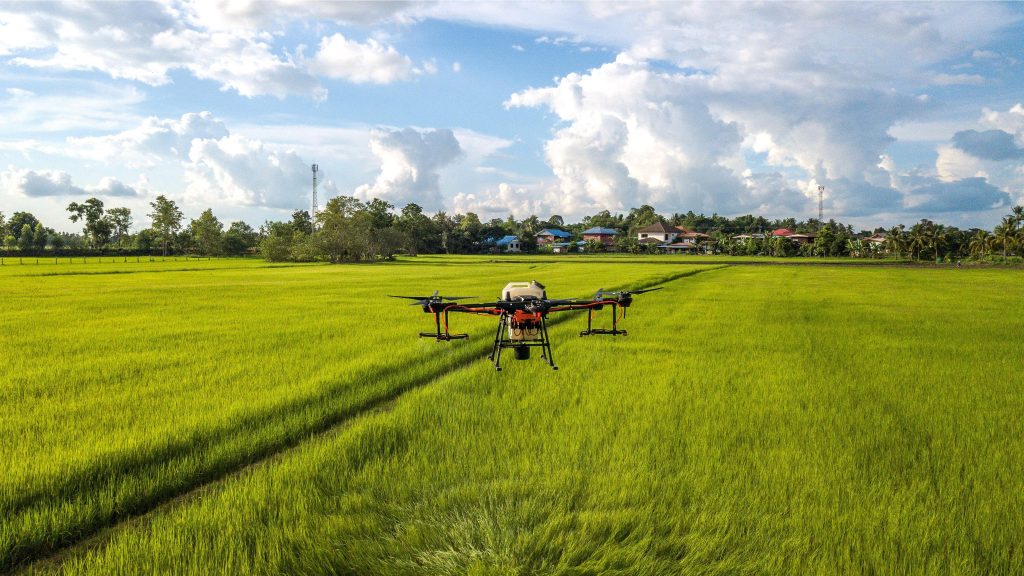What is the connection between drones and crayfish? In Xuyi, Jiangsu, these two unrelated species of wind horse cattle have been cleverly combined: Xuyi’s crayfish are well-known nationwide, and local farmers use drones on shrimp rice co farming farms. Not only can they automatically feed crayfish, but they can also use drones to weed, fertilize, and prevent pests in the rice fields. Some farmers have saved tens of thousands of yuan in labor costs.
On the afternoon of May 25th, in Xuyi, Jiangsu, Dai Rongsong operated a drone on his farm to spread feed on his crayfish. Dai Rongsong, 40 years old, started raising 200 acres of crayfish in 2018. Currently, a family of four operates a shrimp rice co breeding family farm in Xuyi. In the past, when raising crayfish, shrimp feed needed to be sown regularly every day, usually with one person manually rowing and one person spreading the feed. One acre of land required feed ranging from 2-6 kilograms, depending on the feeding situation of the crayfish to determine the amount to be fed the next day. He, his wife, and parents take turns spreading feed, usually starting at 3pm and continuing until 6pm. Starting from last year, his family’s 200 acre crayfish field was changed to shrimp rice rotation. Generally, lobster seedlings were released from the end of March to early April, shrimp were released from the end of May to early June, and after June, water was released for transplanting and rice cultivation. Harvesting began in October. After raising crayfish for a year, he also contracted an additional 400 acres of land for wheat rice rotation.
In March of this year, Dai Rongsong began experimenting with the “new weapon” of lobster farming: he bought a Jifei P100 Pro agricultural drone and began using drones to spread feed to his own crayfish. Originally, the 200 acre crayfish would take three hours of work per day for four people to feed, but now it only takes half an hour to spread feed using drones. In the past, Dai Rongsong had to arrange his work in advance and come back to scatter feed with his family every day. Now, with drones, he can solve the problem of “eating” crayfish in just half an hour after work.
What makes Dai Rongsong most happy is that agricultural drones can not only easily solve the problem of feeding crayfish, but also help him solve rice planting problems such as spraying medicine and fertilizer. He calculated an account: Previously, raising one season of shrimp and planting one season of rice often required hiring temporary workers to help, which would require about 4 workers. At 150 yuan per day, the total labor cost alone may be nearly 60000 yuan. However, now, the cost saved by drones for spreading feed, fertilizing, pest control, and so on can be saved in almost a year, and the second year is basically a net savings in labor costs.
Wang Hui, who raises crayfish in Siyang, Jiangsu, has also become a loyal supporter of agricultural drones. He has now contracted a total of 800 acres and 21 ponds, raising crayfish and hairy crabs. In the past, relying on hiring manual labor to help with breeding in the local area required 7-8 workers. The employees were mostly elderly people around 60 years old in the local area, with a daily cost of 250-300 yuan. On average, it took about 6 months of employment per year. Now with the help of agricultural drones, he can hire 5-6 fewer workers and save around 100000 yuan in labor costs.
Wang Hui introduced that agricultural drone assisted breeding can also solve many pain points that cannot be reached by manpower. For example, manual feeding is not standard or precise enough: if the wind is strong, it is not possible to control the ship. If the feed is scattered in the ditch, crabs cannot eat it and it is easy to waste; Moreover, hairy crabs have high requirements for water quality, and improper placement of feed can also worsen the underwater environment. According to Wang Hui’s calculation, manual dispersal of feed requires buying a boat, feed machine, battery, etc., as well as manually importing feed machines. There are 21 ponds on 800 acres of land, and the cost is around 60000 yuan. Now using agricultural drones to “feed” shrimp and crabs can complete the feeding task of about 800 acres in just 2 and a half hours, saving 5-6 manpower and determining the placement of water plants for the next year based on fixed routes, providing better habitats for crayfish/hairy crabs.
Industry experts say that with the comprehensive promotion of rural revitalization, aquaculture will also make great strides towards digitization and intelligence, gradually achieving large-scale aquaculture and high-quality development. Dai Rongsong and Wang Hui were not the first people to eat crabs, but they were preaching new technologies, showing more young people hope in the countryside and benefiting more agricultural producers from technological development.







Please sign in to comment
register